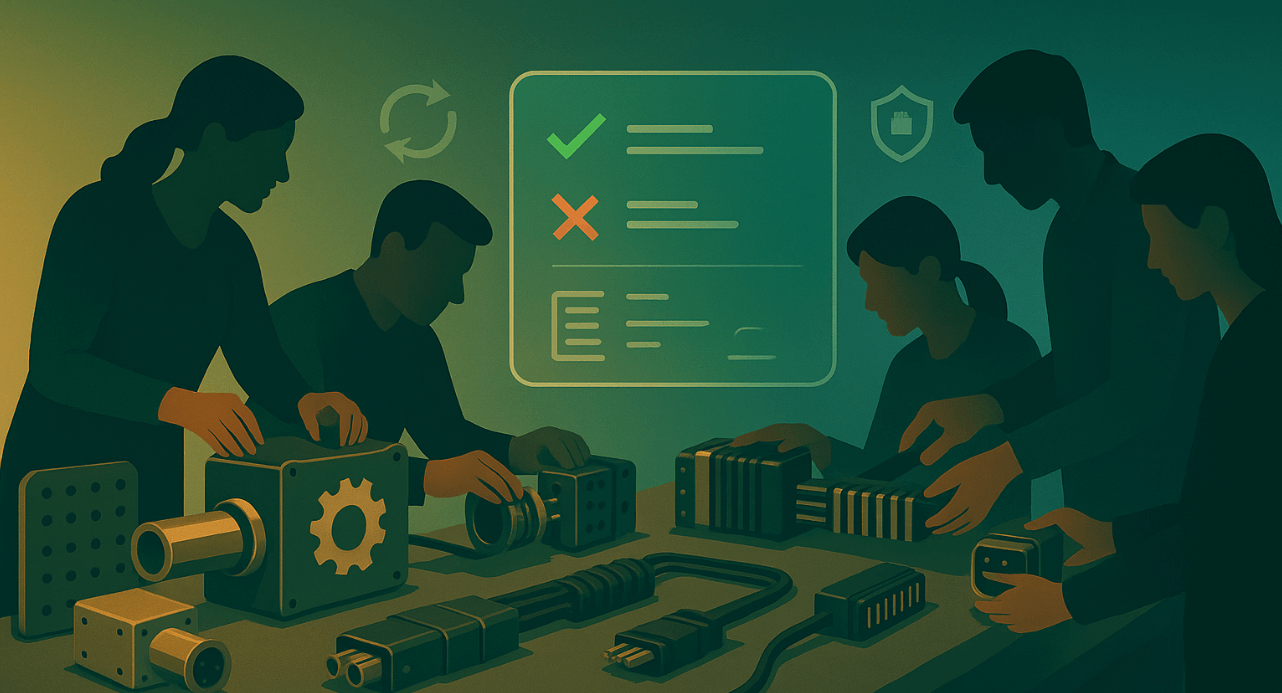Why Complex Systems Break at Checkout
If you’ve ever been on the hook for delivering a large, custom-engineered system, you know the last step—placing the order—should be the easy part. By then, the hard work’s been done. You’ve sat with the client, mapped their requirements, and chosen every part with care. You’ve cross-checked specs, budgets, and delivery windows. Everyone’s nodding. Everyone’s ready.
And then… the checkout page ruins it.
Not because the client changes their mind. Not because a supplier falls through. But because the eCommerce system is built for retail transactions, not multi-component industrial solutions, treats the order like it’s a box of office chairs. No checks. No validation. No awareness that if one part in this system is incompatible, the whole thing will fail.
We’ve watched it happen. A client ordered a high-value control system that included components from multiple suppliers. No one caught that a single power module didn’t meet the voltage spec for the rest of the setup. It passed through checkout without a single flag. Two weeks later, the system failed testing, and we were stuck absorbing the cost of replacements, expedited shipping, and a client whose trust had been shaken.
These aren’t “oops” moments—they’re preventable breakdowns caused by using tools designed for a different world. The world of industrial system integration lives on precision. Every choice is deliberate. Every part is there for a reason. And yet, the moment we move from engineering to ordering, we hand the process over to a system that doesn’t speak the language of dependencies, compliance, or technical validation.
Unlike other online checkouts, ours has to be rethought, not as a simple payment gateway, but as the final checkpoint in the engineering process. A place where configurations are validated in real time, mistakes are impossible to submit, and both buyer and seller walk away knowing the order is 100% correct. Done right, checkout isn’t just a form; it’s the quiet moment that protects your profit, your schedule, and your reputation.
The Nature of Complexity in Industrial System Orders
Ordering a finished consumer product is simple: click, pay, and wait for delivery. Ordering a custom-engineered industrial system is anything but. It’s not a single SKU; it’s a chain of interdependent components, each with its own technical requirements, certifications, and physical constraints. One wrong choice doesn’t just affect that part; it ripples through the entire system.
Think about a large-scale HVAC control solution for a manufacturing plant. You’re not just picking “a controller.” You’re selecting one that works with a specific network protocol, fits inside a certain panel dimension, can handle the facility’s voltage, and meets the building code for that state or country. That one decision influences dozens of others—sensor types, wiring harnesses, communication modules, and even the enclosure material if you’re dealing with extreme environments.
Then there’s compliance. Industrial system integrators often work across regions, and every territory has its own rules. A configuration that’s perfect for a U.S. plant might be illegal in the EU. Or a fire-suppression system might pass in Europe but fail in Canada because of different pressure standards. Standard eCommerce checkout workflows have no idea these rules even exist, much less how to enforce them before the sale.
And it’s not just about avoiding catastrophic mismatches. Many orders fail for smaller, less obvious reasons—like ordering a component that technically fits but requires an adapter not included in the original quote, or pairing two modules that meet spec individually but overheat when placed together. The result is costly back-and-forth with engineering after the sale, exactly what a seamless checkout should prevent.
In this world, “complexity” isn’t a feature; it’s the reality. And until your ordering process speaks that language fluently, you’re leaving a critical piece of your business exposed to error, delay, and customer frustration.
The Hidden Costs of Incompatible Configurations
When a configuration slips through checkout with hidden incompatibilities, the cost isn’t just in replacing the wrong part. The real damage shows up in ways that don’t fit neatly into a spreadsheet.
There’s the direct financial hit—expedited shipping fees to get the right component in place, wasted labor hours for technicians who have to undo and redo work, and materials that can’t be reused. If the system’s price tag runs into six figures, a single error can eat a dangerous percentage of your profit margin.
Then there’s the time cost. In industrial projects, delays don’t just push back delivery dates; they ripple outward. If you’re late delivering a subsystem, your client might be late delivering the final build to their customer, triggering penalties or strained partnerships up the chain. Weeks can vanish from a project timeline over what seemed like a minor ordering oversight.
The relationship cost might be the hardest to measure—but it’s often the most damaging. A client might accept a delay once, but trust is fragile in high-stakes engineering. After one or two missteps, they start quietly considering competitors, even if they never say it out loud. You stop being their “go-to” and start being “one of several options.”
And finally, there’s the opportunity cost. Every hour your engineering or sales team spends putting out fires after a sale is an hour they’re not chasing new business, refining products, or deepening client relationships. That’s growth quietly slipping through the cracks. And it doesn’t take long for those hours to pile up into something you can feel—missed opportunities, delayed projects, slower innovation. The frustrating part? In most cases, it’s completely preventable. But prevention requires rethinking checkout as more than just a payment step—it’s the point where you can either lock in a flawless order or plant the seed of a costly problem you’ll feel months later.
Why Standard Checkout Workflows Fail for System Integrators
The checkout experience most eCommerce platforms offer was designed for speed, not complexity. It’s built to help a consumer buy a single, ready-made product in as few clicks as possible. That’s great if you’re selling shoes. It’s a disaster if you’re selling a multi-million-dollar control system with dozens of interdependent components.
The problem starts with no real-time validation. Standard checkout will happily process an order with incompatible parts because it has no understanding of configuration logic. It doesn’t know that a specific PLC requires a certain firmware version, or that adding one module means you must also include a power supply upgrade.
Then there’s the isolation from engineering data. Most retail platforms have no link to ERP, PLM, CAD, or CPQ systems—the places where compatibility rules, part availability, and compliance requirements live. That means checkout operates blind, disconnected from the very information that would prevent errors.
The interface itself is another limitation. A standard checkout flow funnels buyers through a fixed series of fields—shipping address, payment, confirmation—without adapting to the complexity of industrial system orders. There’s no room for guided configuration assistance, no conditional prompts that adapt based on what’s in the cart, and no automatic adjustments to pricing, lead time, or compliance notices when selections change.
And because it’s all disconnected, the burden of validation shifts to post-sale. Sales or engineering teams only catch errors after the order is placed, forcing them into costly back-and-forth with the client—often under the clock of an already tight delivery schedule.
In other words, the retail checkout model assumes the buyer knows exactly what to order and that what they order will work together. For industrial system integrators, that assumption is not just wrong—it’s dangerous.
Anatomy of a Validated Checkout Customization for Complex Industrial Systems
If a standard checkout is like a security guard waving people through without looking, a validated configuration checkout is more like having an engineer right there—checking every part, every dependency, and every compliance rule before the order gets the green light. It’s not just “smart checkout”; it’s embedded engineering that catches mistakes before they happen.
Pre-Checkout Guidance
The process starts before the buyer even clicks “Add to Cart.” Instead of letting them wander into a bad combination, the system guides their choices. Pick one component, and the rest of the options narrow automatically to what’s actually compatible. It’s not just filtering—it’s teaching, so even a non-technical buyer can’t accidentally choose something that won’t work.
Real-Time Validation
Every tweak the buyer makes runs through a live set of rules:Does this motor require a specific controller? Will adding that sensor break compliance for the target market? If something’s off, the system stops the order, explains the conflict, and points the buyer toward a fix.
ERP and PLM Integration
Validation only works if the data is solid, and in many cases, complex configurations require customers to provide precise technical specifications up front. That’s why the system doesn’t rely on static files or old spreadsheets; it pulls live specs, current stock levels, accurate lead times, and up-to-date regulatory data straight from your ERP, PLM, and even CAD systems. No outdated PDFs, no guesswork—just the latest information guiding every choice a buyer makes.
And the moment a part changes, so does everything else. Pricing is recalculated on the spot, lead times update automatically, and shipping estimates adjust in real time. The buyer knows exactly what to expect before they place the order—no surprises, no last-minute delays. That way, a small swap doesn’t turn into a three-week delay that no one warned the customer about.
Compliance and Localization Checks
Selling across borders? The system already knows the rules. Pick a component that violates an EU directive or fails UL certification, and the buyer gets flagged right away—complete with alternative suggestions.
A validated configuration checkout isn’t just there to prevent errors. It builds confidence. Buyers know they’re ordering exactly what they need. Your team knows they can deliver without rework. And both sides move forward without that nagging worry something might go wrong after the order’s placed.
Designing the Buyer Journey for Complex Systems
A validated checkout system is only half the equation. The other half is the buyer’s experience, the journey that takes them from the first click to the final confirmation without confusion, hesitation, or frustration.
Industrial buyers are not all the same. Some know exactly what they need down to the part number, while others only know the outcome they’re after. Your checkout has to serve both without forcing one to adapt to the other’s process while giving buyers complete control over how their system is configured. That means building a guided path that adapts to the buyer’s knowledge level.
For the technical buyer, the system can offer shortcuts: search by SKU, upload a BOM, or pull in past order history for quick reconfiguration. For the less technical buyer, the interface should guide them through logical steps, explaining why certain checkout options are unavailable and offering compatible alternatives that still meet their needs—delivering a truly customized experience that feels built around their needs. This isn’t about “dumbing down” the process; it’s about removing doubt at every stage.
Visual tools help enormously here. A real-time schematic that updates as components are added or removed makes abstract compatibility rules tangible. Instead of text warnings like “Incompatible selection,” the buyer sees a visual cue showing the conflict in context. This does more than just cut down on errors; it builds trust, because buyers can actually see the reasoning behind every validation instead of taking it on faith.
And that trust carries forward when the system preserves configuration history. If a client comes back months later to reorder or tweak a system, they shouldn’t have to start over. They should be able to pull up their exact validated configuration instantly, with every choice and rule still intact. That continuity saves time, prevents new mistakes, and reinforces you as the partner who remembers their needs as clearly as they do.
Ultimately, the buyer’s experience shouldn’t feel like ‘filling out a form.’ It should feel like collaborating with an expert, so by the time they reach the payment methods screen, every choice has been validated and they’re simply confirming a flawless order.
Technology Stack & Integration Strategy
A validated configuration checkout isn’t something you can buy off the shelf and plug in. It’s a system you build, so every tool that “knows” something about your products can talk to the others in real time.
It starts with your eCommerce platform, but not the version you get out of the box. BigCommerce, Shopify Plus, Magento… any of them can work, but they need tailoring. Out of the gate, they don’t natively run configuration logic, apply dynamic rules, or adapt checkout settings to trigger validation prompts without slowing the experience down. You have to extend them, so those checks and calculations happen behind the scenes while the buyer moves through the process naturally.
Then comes the middleware layer, which is easy to overlook but ends up doing the heavy lifting. It’s the bridge—the place where APIs and integration tools move information back and forth between your storefront and the systems that hold the truth. Your ERP feeds it live availability, lead times, and cost data. Your PLM and CAD systems supply technical specs, compatibility rules, and engineering constraints, and your CPQ engine keeps pricing logic accurate, making sure a change in configuration instantly updates cost estimates.
Security isn’t optional. if you’re passing CAD files, BOMs, or proprietary engineering data through this workflow, you need authentication, role-based access, and encryption in transit. One leak, one unauthorized download, and you’re not just fixing a technical problem—you’re rebuilding trust.
Finally, all of that complexity has to land in a way the buyer can actually use. That’s the presentation layer. This is where your front-end devs and UX designers take the dense, rule-heavy backend and turn it into a clean, fast, friction-free interface.
When it’s working right, the stack doesn’t just “support” checkout; it works like an extra set of eyes and hands for your engineering and sales teams, catching mistakes before they leave the cart and giving the buyer an experience that feels precise, reliable, and effortless.
Building Validated Checkout on Shopify and BigCommerce
For most industrial system providers, the biggest mistake with eCommerce platforms is assuming the default checkout is “good enough.” BigCommerce and Shopify both give you powerful, enterprise-ready foundations—but those foundations are built for simple, consumer-style transactions. If you sell multi-component, custom-engineered systems, leaving them unmodified is like trying to run a precision manufacturing plant with off-the-shelf hand tools.
The difference between a standard checkout and a validated configuration checkout is night and day. One simply records the order; the other actively safeguards it. To make either Shopify or BigCommerce work for complex systems, you have to think in terms of custom frameworks, not plug-and-play storefronts.
BigCommerce: Extending an Already Flexible Core
BigCommerce comes with an open API architecture and the Stencil front-end framework, which makes it easier to inject configuration logic into the buying process itself. The goal isn’t to rip out the existing checkout—it’s to weave engineering intelligence into it. That means:
Real-time compatibility checks: As buyers select components, the system silently tests each choice against your engineering rules, blocking incompatible combinations before they hit the cart.
Data-driven decision-making: By integrating BigCommerce with ERP, PLM, CPQ, and CAD systems through middleware, the storefront pulls live inventory, pricing, lead times, and compliance data directly into the buyer’s view. If a component goes out of stock or changes specs, the update is immediate—no one is left ordering yesterday’s configuration.
Buyer-specific precision: Using BigCommerce’s native multi-location inventory and customer group pricing, you can make sure the parts, prices, and timelines shown are correct for that buyer’s region, account type, and negotiated terms—without manual intervention.
The result? Buyers feel like they’re checking out on a normal store, but in the background, you’ve got a configuration engine working at engineering speed and precision.
Shopify: Power Through Extensibility and Apps
Shopify Plus takes a different route when it comes to customization. Its liquid templating language, script editor, functions, and Plus-exclusive checkout extensibility open the door to some powerful tweaks. It doesn’t let you dig quite as deep into native checkout as BigCommerce does, but with the right setup, you can still get to the same level of validation.
That might mean adding pre-checkout validation layers—using Shopify Scripts or custom apps to run compatibility checks before the cart is finalized. The system can quietly block parts that don’t belong together, prompt buyers to add what’s missing, or even adjust lead times automatically when a change affects production.
It can also mean pulling in live ERP, PLM, and CAD data through connectors or middleware. Shopify’s massive app marketplace makes it possible to wire up those integrations without reinventing the wheel. When that data flows directly into the storefront, the buyer is seeing the same specs, availability, and constraints your internal teams use.
Then there’s the option to build custom configuration experiences—guided product pages that respond to every selection, hide incompatible options, and even update schematics on the fly. It turns the buying process into something intuitive, even for complex systems.
Speed + Precision: A Unified Outcome
Whichever platform you choose, the goal is the same: a checkout that works like a silent engineer. Every choice is validated in real time. Errors are caught before they ever exist. Orders leave your system right the first time.
For the buyer, it feels effortless, just another smooth checkout. For you, it means some reworks, a shorter sales cycle, and the peace of mind that comes with knowing every order in production is already engineered to succeed.
Change Management for Internal Teams
Rolling out a validated configuration checkout system isn’t just a tech upgrade; it changes how people work. You’re not only installing software; you’re redefining how sales, engineering, and customer service interact day to day. Ignore the human side of that shift, and even the smartest system can fall flat.
It starts with building trust inside your own walls. Sales teams, especially the seasoned reps, may be wary of automation. They’ve spent years catching configuration errors by hand, and they’ll wonder if a system can really match their judgment. Bring them in early. Let them run real orders through the validation engine, see the catches it makes, and feel the relief of focusing on relationships instead of policing specs.
Engineering comes with a different concern—not losing control, but being swamped with exceptions because the rules weren’t set up right. That’s why knowledge transfer is critical in the build phase. The logic has to mirror real engineering standards, not assumptions from IT or marketing. When engineers see the system enforcing the same rules they use in-house, they’ll start trusting it.
Customer service needs to treat the system as a tool for preventing problems, not just fixing them. If a buyer calls with a change, reps should be able to run it through validation on the spot and saving everyone from post-sale headaches.
In the end, change management is about making the new process feel like an upgrade, not an obligation. When every team sees the system as a shared safety net—protecting margins, timelines, and reputation—it stops being “checkout software” and becomes part of how the company operates.
Competitive Advantages of Validated Checkout
In industrial system integration, a flawless order isn’t just “nice to have.” It’s the kind of thing buyers remember. When you remove the risk of configuration errors before the sale even closes, you’re giving buyers confidence to move forward without hesitation. It’s especially powerful with prospects who’ve been burned before—people who’ve lost time, money, and patience because a supplier delivered something that didn’t match the spec. For them, your process isn’t just a feature. It’s a guarantee.
It changes the pace, too. With real-time validation, there’s no limbo period where everyone’s waiting on engineering to confirm an order. Buyers get answers immediately. The deal keeps moving. And momentum, once lost, is hard to get back—this keeps it alive.
From a sales and marketing perspective, “error-free ordering” is more than a technical claim. It’s something you can lead with. It says you’re not just selling parts or systems—you’re protecting the client’s schedule, budget, and reputation. And in industries where downtime costs thousands per minute, that’s a message that hits home.
Meanwhile, competitors are still untangling mistakes after the sale. Your team? They’re free to deliver, improve, and go win the next job. That extra breathing room is where growth happens.
Validated checkout turns what most companies treat as a hidden, back-office process into a selling point right at the front line. And in the right hands, it’s not just an improvement—it’s become a weapon.
ROI Framework – Measuring the Impact
For all its operational upside, a validated configuration checkout still has to earn its keep in numbers. The leadership team doesn’t just want theory—they want proof. That means tracking the right metrics before and after launch so the gains are obvious.
A good place to start is error rate reduction. If your current process lets 15–30% of orders slip through with configuration issues, bringing that number down to zero isn’t just nice—it’s measurable. Tally the savings in rework, expedited shipping, and wasted labor. On its own, that can cover the investment.
Then look at sales cycle speed. When validation happens instantly instead of after an engineering review, how many days disappear from your average time-to-close? Shorter cycles mean more deals can move through each quarter.
Watch your average order size too. Once buyers trust the process—and know their configurations will be right—they’re more likely to commit to bigger, more complex orders. Track whether deal values start climbing post-rollout.
Don’t skip customer satisfaction and renewal rates. In industrial integration, repeat business is where long-term growth lives. Fewer post-sale headaches almost always mean higher retention.
Pull those metrics together into one clear ROI story. That’s when the case really lands—you’re not just showing operational efficiency, you’re proving the system grows revenue, protects margins, and strengthens customer relationships. That’s the kind of evidence even the most cautious CFO can get behind.
Validated Checkout Toolkit
For Industrial System Providers on Shopify & BigCommerce
Quick Diagnostic: Do You Need Validated Checkout?
| Symptom | Yes / No |
| Orders include multiple interdependent components | ☐ / ☐ |
| Post-sale engineering review catches >5% errors | ☐ / ☐ |
| Compliance rules vary by buyer location | ☐ / ☐ |
| Buyers often require configuration guidance | ☐ / ☐ |
| Lead times change with configuration changes | ☐ / ☐ |
If you checked 3 or more, validated checkout will likely protect margin & reputation.
Core Capabilities Checklist
☐ Real-Time Compatibility Checks — Block incompatible parts before cart finalization
☐ ERP / PLM / CAD Integration — Pull live specs, pricing, lead times, and compliance data
☐ Guided Buyer Journeys — Narrow options automatically based on prior selections
☐ Compliance & Localization Rules — Flag regional regulation conflicts instantly
☐ Visual Config Validation — Show schematic updates as changes are made
☐ Configuration History Recall — Enable quick reorders with previous validated builds
Platform Strategy Snapshot
| Platform | Strength | Key Customization |
| BigCommerce | Open API, flexible Stencil front-end | Embed engineering logic directly into checkout; integrate with ERP/PLM via middleware |
| Shopify Plus | App ecosystem, script editor | Add pre-checkout validation layers; use guided product pages & dynamic schematics |
ROI Scorecard
| Metric | Before | After | Gain |
| Error Rate | ____% | ____% | ____% |
| Avg. Time-to-Close | ____ days | ____ days | ____ days saved |
| Avg. Order Value | $____ | $____ | +____% |
| Customer Retention | ____% | ____% | +____% |
Tip: Fill in quarterly to prove value to leadership.
5. Change Management Must-Dos
Rolling out validated checkout isn’t just a tech upgrade—it changes workflows, roles, and responsibilities. Here’s how to get every department aligned:
Sales Enablement
☐ Involve sales early: Let them test real orders in the new system during pilot phase.
☐ Highlight time savings: Show how automation frees them from manual spec checks so they can focus on relationship-building and closing deals.
☐ Provide quick-reference guides: Scripts and talking points for explaining “error-free ordering” as a selling point.
Engineering Integration
☐ Embed engineering rules: Pull actual PLM/ERP configuration logic—not assumptions—into validation rules.
☐ Run controlled “break tests”: Try to push bad configurations through the system to confirm it catches them.
☐ Assign an engineering “rule keeper”: Responsible for updating validation logic when specs or compliance change.
Customer Service
☐ Train on real-time validation use: When a buyer calls to change an order, service reps run it instantly through the same checks.
☐ Equip with troubleshooting prompts: For explaining why an order can’t proceed and offering compliant alternatives.
Leadership Alignment
☐ Set clear KPIs: Tie success to reduced rework costs, faster sales cycles, higher retention.
☐ Review progress monthly: Use the ROI scorecard (Section 4) in leadership meetings to show wins and spot gaps.
☐ Promote the cultural shift: Reinforce that validation is part of delivering quality, not a bureaucratic hurdle.
Key Principle: The goal is to make the system feel like a shared safety net that protects everyone’s time, margins, and reputation—not just “checkout software.”
From Sales Obstacle to Competitive Weapon
For most industrial system integrators, checkout is treated like a necessary formality—the paperwork you have to get through to lock in the sale. But the truth is, it’s the most strategic moment in the entire buying process. It’s the point where the promise you’ve made to the customer becomes real. It’s also the point where you can either eliminate every last risk… or let a hidden error slip through and poison the project before it’s even built.
When you turn checkout into a validated, data-driven, fully integrated step in your sales process, you’re doing more than catching mistakes. You’re making a statement: we will not waste your time, your money, or your trust. That message resonates with buyers who’ve been burned before. It builds a reputation that marketing dollars can’t buy.
And here’s the thing—once you’ve built it, you’ve got something your competitors can’t easily copy. Technology is only half the barrier; the real moat is the operational discipline and team alignment behind it. That’s why companies that make this leap don’t just protect margins—they start winning deals they would’ve lost before.
If you’re still running complex, high-value orders through a generic checkout that treats them like consumer products, you’re leaving your reputation, your profits, and your future in someone else’s hands. There’s a better way.
If you’re ready to turn your checkout from a bottleneck into a competitive advantage, contact us. We can show you exactly how to build a system that validates every configuration, safeguards your margins, and makes your customers trust you more with every order they place.












